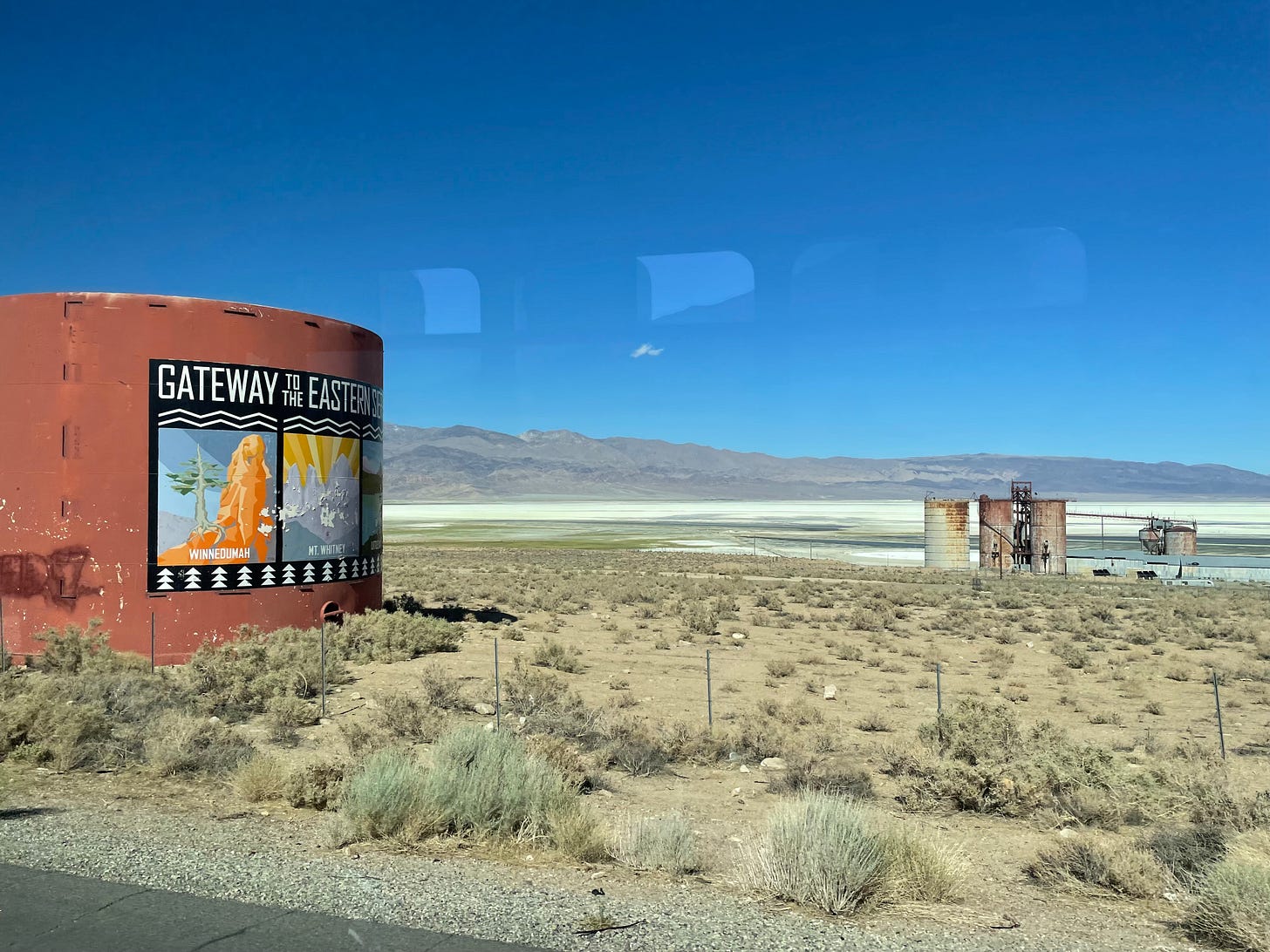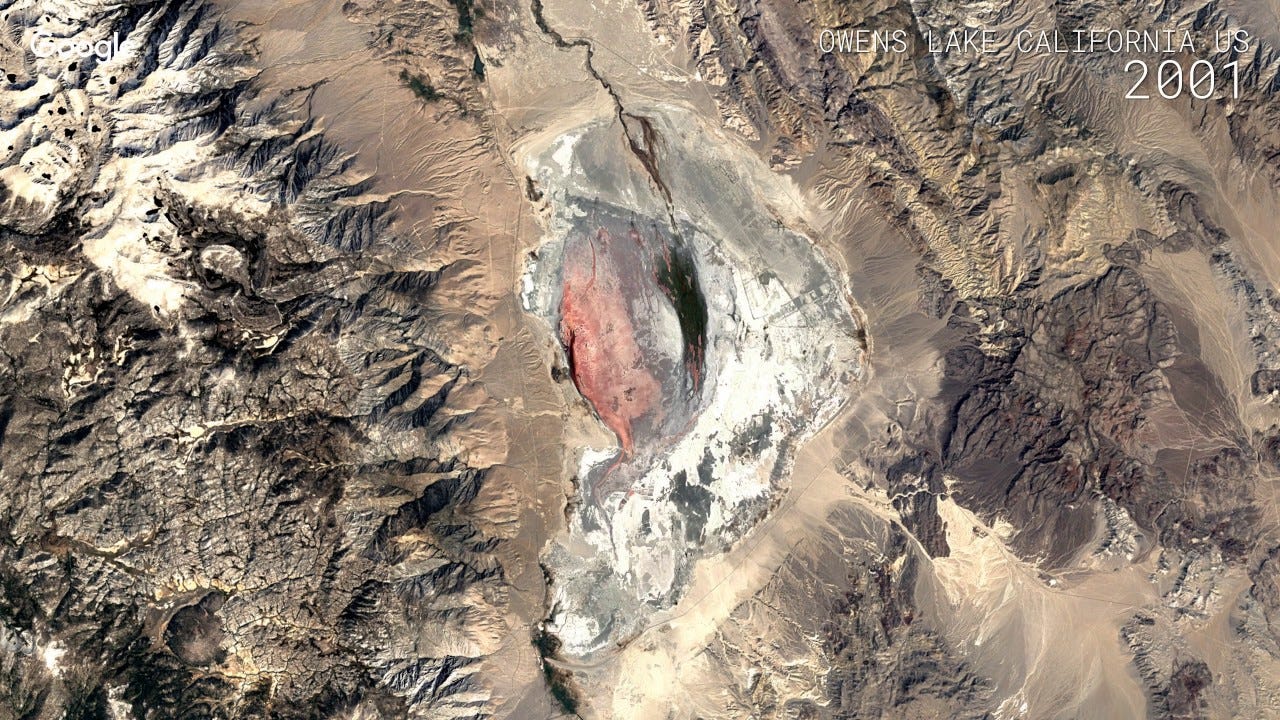Land Back in the Valley of Stolen Water
On LADWP’s role in the Eastern Sierra, and new projects restoring water and land access in Payahuunadü
Chalky salt, like the outline for a dead body—only the outline is full, and vast, as the body once was itself. That’s how I might describe it, to prepare you to see the remnants of the body of water that once was Owens Lake, had you never been up Hwy. 395.
I still remember trying to make sense of what I was looking at, the first time I set eyes on it. I was a new resident of Los Angeles at the time, on the way to my first-ever hike in the Eastern Sierra, and barely aware of the devious history that had killed the lake and much of the surrounding valley. That history, sometimes referred to as the California Water Wars, has been made rather notorious through books such as Cadillac Desert or the more fictionalized film Chinatown. Even if I had absorbed those stories, I don’t know that it would have prepared me for the sight of that dead lake. But I have surely remembered its active ghostly presence ever since.
This summer, as I sat in a shuttle on my way toward Lone Pine, preparing to haul myself and two weeks of supplies up and over Tumanguya, I was simultaneously preparing for meeting the lake once again, with its heavy-handed reminder of how contorted our relationship to the elements necessary for life have become.
Here’s a short timelapse video of the lakebed, to get a sense of the scale:
Even as terrible as the secretive machinations of the Los Angeles Department of Water and Power might have been as its leaders went about forcefully acquiring land and water rights, it turns out that even the dramatized accounts are missing some of the worst of the evil doing, a result of the habitual partiality with which we tell history on this continent. By which I mean that the standard accounts of the theft of water from the Owens River Valley are typically told with a focus on the White landowners in the area, who at the time were close descendants of or even possibly homesteaders themselves, and thereby the agents of displacement for the Paiute and Shoshone, who had been managing the use of the Owens River long before the LADWP ever showed up on the scene. Just take a quick skim of that Wikipedia article that I linked on the ‘water wars,’ and you’ll see what I mean; the Paiute get a mention but then just sort of quietly disappear from the story.
Today, members of the Owens Valley Indian Water Commission (a body with representatives from the Paiute and Shoshone tribes in Bishop, Big Pine, and Lone Pine) are correcting this omission in their work throughout the valley, including their online story map, Reimagining Payahuunadü. There, they outline the longer history of the tribes in the valley, and the ongoing work to claim water rights that are legally due to them, both federally and from past agreements with the City of Los Angeles. (The yellow in the image below, pulled from the story map, is the land currently claimed by Los Angeles on Paiute and Shoshone territory.)
That longer history includes having their promised reservation land revoked via executive order:
Then on July 16, 1933 Roosevelt (Exec Order 6206) temporarily withdraws the entire Owens River watershed “in aid of legislation for the protection of the water supply of Los Angeles” – including the 67,120 acres of volcanic tableland from trust.
Negotiations about water and land between the tribes and the City of Los Angeles continue, but in the meantime, new approaches are being tried. Among these are the purchase of a property known as Three Creeks, held by the current owner with a focus on conservation but also fostering connection to land. That owner has agreed to sell to the Owens Valley Indian Water Commission and partners, who have formed a group they call the Three Creeks Collective. The Three Creeks Collective is currently fundraising to complete the purchase of that land:
My trip through the Sierra Nevada, in Payahuunadü (a name I did not know at the time), served as the source for a number of posts here on Unsettling last summer (see “Fire Season Arrives” and the three-part series wrestling with legacy of John Muir). So this effort to restore land and water access to the Indigenous people of Payahuunadü felt like an appropriate choice to support with the portion of subscription fees marked for donating from the second half of last year.
For newer readers: 10% of what comes through in subscriptions at Unsettling gets sent back out to fund efforts that put into practice many of the ideas we discuss here; funds from the first half of 2022 went to an Agrarian Commons project in central Virginia. If you like what you read here, and like the idea of funding projects such as these, please consider becoming a paid subscriber.
If you watch the video above, you’ll see images of what waterways in the Owens Valley can look like. It’s a far cry from both the desiccated remains of Owens Lake and the nearby desert landscapes that stretch into Nevada. The land is lush, full of life, from plants to pelicans and herons. It makes one understand how a people could give this place a name that means “land of the flowing water.”
In the video they also make a claim that they could be the first Indigenous people on Turtle Island to receive land back. While that might have been true at the inception of their project, that’s certainly no longer the case. Times are changing, so much so that in a post awhile back I asked, is Land Back going mainstream? I felt a little cheeky about that at the time, but you have to say, getting on the Rotary Club agenda (as I happened to see The Owens Valley Indian Water Commission and Three Creeks Collective are this February) feels pretty mainstream. And that’s in Bishop, a town with a higher proportion of Republican voters and overall more conservative climate.
Still, there’s a long road ahead and plenty of work to be done. If you’d like to help speed it up a little more, and make a more direct contribution to this work in the Owens Valley, you can do so at their Go Fund Me site. And I know that there’s a fair number of L.A. residents on this list here; you all are especially well situated for making an impact by helping share not just the fundraiser but also the fuller version of the water wars history, so why not do that?
As always, thanks for reading. Until next time,
Meg






